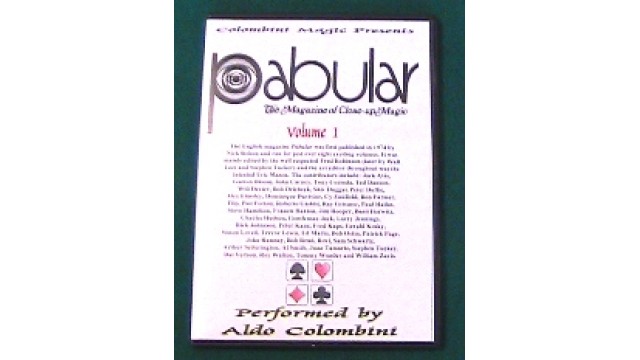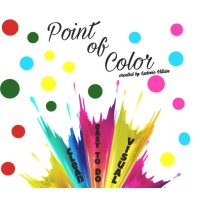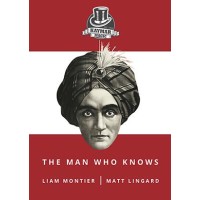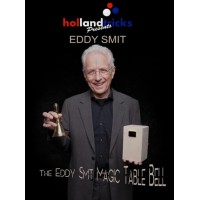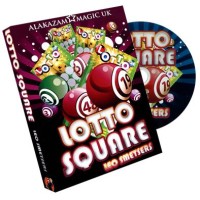Pabular 1 by Aldo Colombini
- Product Code: C1#297
- Reward Points: 5
- Availability: In Stock
- $4.03
-
$1.99
- Price in reward points: 199
The English magazine Pabular was first published in 1974 by Nick Bolton and ran for just over eight exciting volumes. It was mainly edited by the well respected Fred Robinson (later by Walt Lees and Stephen Tucker) and the art editor throughout was the talented Eric Mason. The contributors include: Jack Avis, Gaeton Bloom, John Carney, Peter Duffie, Alex Elmsley, Dominique Duvivier, Cy Endfield, Bob Farmer, Flip, Piet Forton, Roberto Giobbi, Paul Hallas, Steve Hamilton, Francis Haxton, Larry Jennings, Peter Kane, Fred Kaps, Gerald Kosky, Trevor Lewis, Ed Marlo, Bob Ostin, Patrick Page, John Ramsay, Bob Read, Sam Schwartz, Arthur Setterington, Al Smith, Juan Tamariz, Stephen Tucker, Dai Vernon, Roy Walton, Tommy Wonder and William Zavis.
CONTENTS:
- SPECTATOR MAGICIAN (Tony Faro): Here is a great card effect entirely performed in the spectator hands and totally impromptu. You'll never stop using it.
- SLOW MOTION RING RELEASE (Peter Kane): A ring is threaded onto a piece of string (or rope) and it becomes free.
- COLOUR-PSYCHOLOGY (Stanton Carlisle): Four envelopes are shown and three are selected by spectators. They open the envelopes and inside they find consolation messages, while the last envelope (for you) contains a $100 bill (or any bill denomination).
- ONE AT A TIME COLLECTORS (Alex Elmsley): Three chosen cards appear, one at a time, reversed among the four Aces.
- UP, DOWN & AROUND (William Zavis): Four black cards penetrate, reverse themselves among and change places with a number of red cards Great packet trick.
- SIMPLICITY (Trevor Lewis): You show Ace to Five of Spades (or any five cards). A spectator THINKS of one card and then names it. The card is removed. The remaining four cards are shown to be (say) blue-backed and the selection is the only red-backed card.
- PAIRED CHOICE (Francis Haxton): Two freely selected cards appear at the same time while you deal two packets of cards.
- CHOP-COIN (Arthur Setterington): Two different coins are wrapped in a banknote and secured with a clip which is placed on a chopstick. You ask for a coin to be named. The selected coin disappears from the note. Everything can be examined.
- GONE SANDWICH (William Zavis): The two red Aces are inserted face down into a half of the deck. A selection is inserted in the other half. The Aces disappear from their half and reappear in the other half trapping the selected card.
- DIARY DICE-CARD (Des Colgan): You show a diary (or a calendar) and a spectator selects a card. The same card is printed in the diary on the day of the performance.
Reviews (0)
Related Products
The Digital Pabular - The Magazine of Close-Up Magic
The Digital PabularPDFThe digital version of Pabular Magazine - long considered to be one of the fin..
$2.99 $7.99
Totally Impromptu by Aldo Colombini
Aldo Colombini - Totally Impromptu Impromptu card magic performed with a regular deck of cards Cont..
$1.99 $4.48
Top Ten by Aldo Colombini
Aldo Colombini - Top Ten Ten more card tricks using regular cards. Contents: INDIC..
$1.99 $4.23
Self Working Packet Tricks by Aldo Colombini
Easy packet tricks performed with regular cards and with virtually no sleight-of-hand. MEREL..
$1.99 $4.23
Karl Fulves The Chronicles by Aldo Colombini
Karl Fulves' legendary magazine The Chronicles was limited to 36 issues, from 1978 to 1988, during t..
$1.99 $4.23
Double Decker 1 by Aldo Colombini
Routines with two decks of cards. CONTENTS: COINCIDENTAL CUT (Arthur Setterington): You ..
$1.99 $4.73
Across the Void by Paul Hallas
An examination of the classic “Cards Across” effect which discusses and explains many methods and pr..
$3.00 $33.00
The Magic of ESP by Stanton Carlisle
This book contains 25 masterly-conceived effects using ESP cards. This is a must-have book is for ev..
$1.99 $22.00
Sam Schwartz - Anagramatic
First conceived in 1963, ANAGRAMATIC is Sam Schwartz's seemingly impossible word divination masterpi..
$1.99 $7.00
Stanton Carlisle - Mentalismo Deluxe
Eight strong and wonderful mentalism routines."Key Caper" for example is a completely ungimmicked ve..
$0.99 $9.00
Recommend
Point Of Color by Ludovic Villain
With these divinatory cards you will be able to guess the color thought by the spectator.The explana..
$2.99 $5.99
Espredict by Ludovic Villain
Place a prediction on the table. Then show your spectators your ESP cards. Invite a spectator to shu..
$1.99 $4.99
The Lucky Coin by Luca Volpe
Luca Volpe and Paul McCaig are proud to present a classic of magic re-imagined! The Lucky Coin is..
$1.99 $4.99
Vanish Magazine October November 2015 by Lu Chen
Lu Chen - VANISH Magazine October November 2015..
$0.99 $3.99
Clear Through by Lonnie Chevrie
Lonnie Chevrie is a full-time working professional magician. The only rule is, it has to be a strong..
$0.99 $3.99
Fu2 by Lloyd Barnes
WARNING! Not suitable for magicians under 18 years old. Please ensure you meet the age requir..
$2.99 $5.99
Light It Up Classic Walnut
Imagine having the power to summon a flame at your will with just your mind. Completely hands-free, ..
$1.99 $4.99
The Man Who Knows by Liam Montier
A new version of 'The Man Who Knows' featuring a smaller set of cards (ideal for pocket management..
$1.99 $4.99
Ritual by Lewis Le Val
Mentalism With Greater Purpose What if you suddenly found the ability to c..
$2.99 $5.99
The Eddy Smit Magic Table Bell by Leo Smetsers
Special trick with a limited edition of 100 pieces. In 1989, Eddy Smit introduced his Magic T..
$1.99 $4.99
Rob Ziekman Karate 1996 by Leo Smetsers
Holland Tricks and Rob Ziekman presents an easy-to-do trick that gets great reactions from your au..
$2.99 $5.99
Multi-Wallet by Leo Smetsers
The Multi Wallet by Leo Smetsers is super cool. Leo has taken a Himber styl..
$2.99 $5.99
Lotto Square by Leo Smetsers
From the creative mind of Leo Smetsers comes Lotto Square. A deviously simple close-up ..
$2.99 $5.99
Flight Case by Leo Smetsers
Flight Case Prediction by Leo Smetsers is a high quality super-fast “Item to Impossible Location” ..
$2.99 $5.99

